Joshua Melton
Two-Stage Stance Labeling: User-Hashtag Heuristics with Graph Neural Networks
Apr 16, 2024Abstract:The high volume and rapid evolution of content on social media present major challenges for studying the stance of social media users. In this work, we develop a two stage stance labeling method that utilizes the user-hashtag bipartite graph and the user-user interaction graph. In the first stage, a simple and efficient heuristic for stance labeling uses the user-hashtag bipartite graph to iteratively update the stance association of user and hashtag nodes via a label propagation mechanism. This set of soft labels is then integrated with the user-user interaction graph to train a graph neural network (GNN) model using semi-supervised learning. We evaluate this method on two large-scale datasets containing tweets related to climate change from June 2021 to June 2022 and gun control from January 2022 to January 2023. Experiments demonstrate that our user-hashtag heuristic and the semi-supervised GNN method outperform zero-shot stance labeling using LLMs such as GPT4. Further analysis illustrates how the stance labeling information and interaction graph can be used for evaluating the polarization of social media interactions on divisive issues such as climate change and gun control.
Flurry: a Fast Framework for Reproducible Multi-layered Provenance Graph Representation Learning
Mar 05, 2022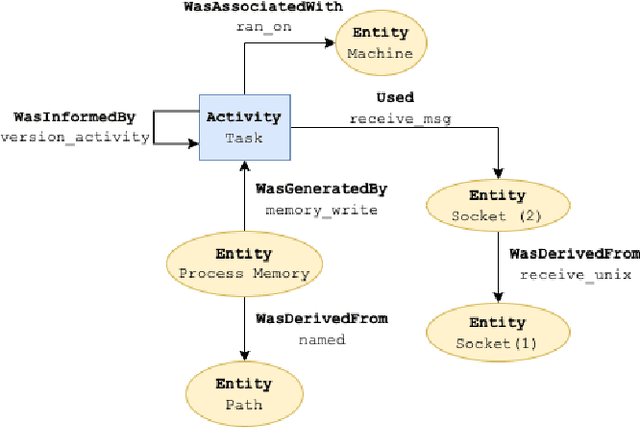
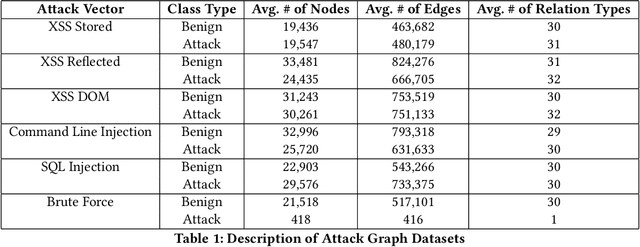
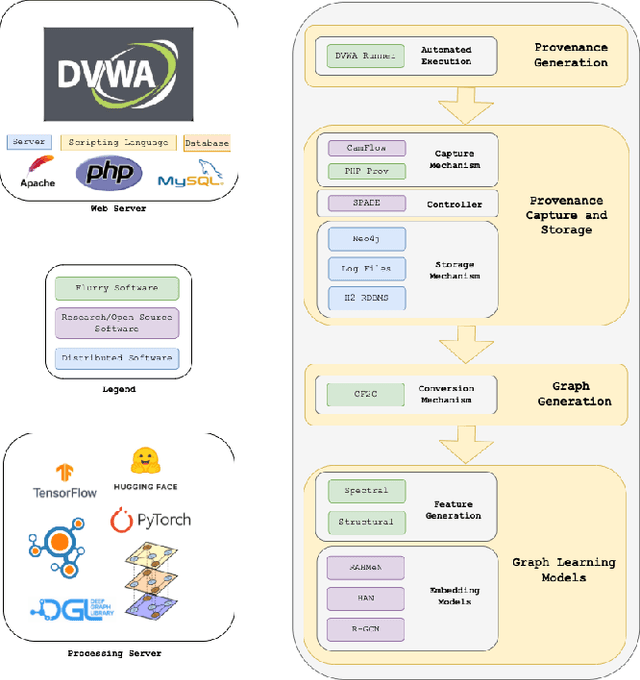

Abstract:Complex heterogeneous dynamic networks like knowledge graphs are powerful constructs that can be used in modeling data provenance from computer systems. From a security perspective, these attributed graphs enable causality analysis and tracing for analyzing a myriad of cyberattacks. However, there is a paucity in systematic development of pipelines that transform system executions and provenance into usable graph representations for machine learning tasks. This lack of instrumentation severely inhibits scientific advancement in provenance graph machine learning by hindering reproducibility and limiting the availability of data that are critical for techniques like graph neural networks. To fulfill this need, we present Flurry, an end-to-end data pipeline which simulates cyberattacks, captures provenance data from these attacks at multiple system and application layers, converts audit logs from these attacks into data provenance graphs, and incorporates this data with a framework for training deep neural models that supports preconfigured or custom-designed models for analysis in real-world resilient systems. We showcase this pipeline by processing data from multiple system attacks and performing anomaly detection via graph classification using current benchmark graph representational learning frameworks. Flurry provides a fast, customizable, extensible, and transparent solution for providing this much needed data to cybersecurity professionals.
Pay Attention to Relations: Multi-embeddings for Attributed Multiplex Networks
Mar 03, 2022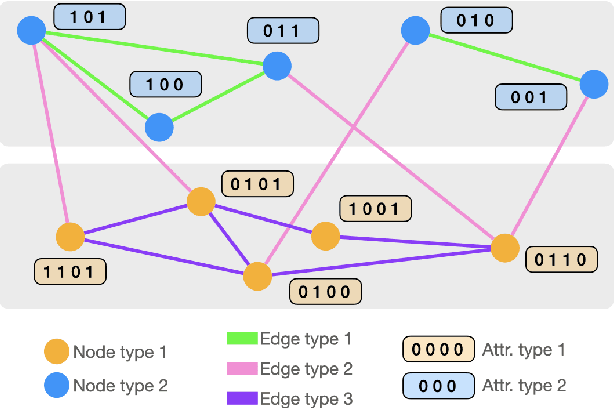
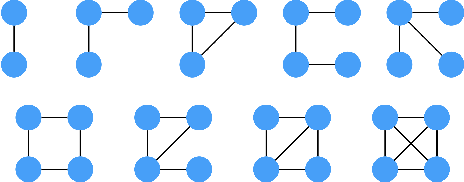

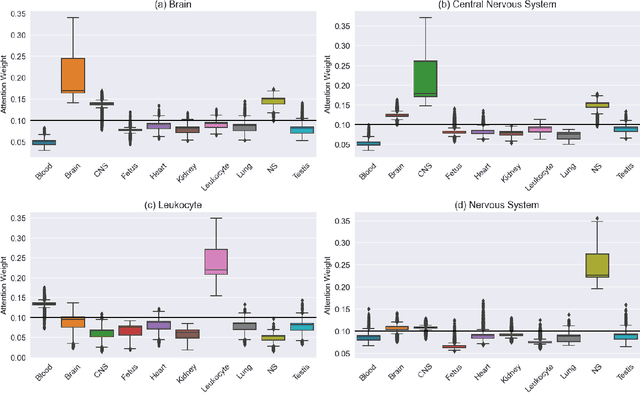
Abstract:Graph Convolutional Neural Networks (GCNs) have become effective machine learning algorithms for many downstream network mining tasks such as node classification, link prediction, and community detection. However, most GCN methods have been developed for homogenous networks and are limited to a single embedding for each node. Complex systems, often represented by heterogeneous, multiplex networks present a more difficult challenge for GCN models and require that such techniques capture the diverse contexts and assorted interactions that occur between nodes. In this work, we propose RAHMeN, a novel unified relation-aware embedding framework for attributed heterogeneous multiplex networks. Our model incorporates node attributes, motif-based features, relation-based GCN approaches, and relational self-attention to learn embeddings of nodes with respect to the various relations in a heterogeneous, multiplex network. In contrast to prior work, RAHMeN is a more expressive embedding framework that embraces the multi-faceted nature of nodes in such networks, producing a set of multi-embeddings that capture the varied and diverse contexts of nodes. We evaluate our model on four real-world datasets from Amazon, Twitter, YouTube, and Tissue PPIs in both transductive and inductive settings. Our results show that RAHMeN consistently outperforms comparable state-of-the-art network embedding models, and an analysis of RAHMeN's relational self-attention demonstrates that our model discovers interpretable connections between relations present in heterogeneous, multiplex networks.
DeL-haTE: A Deep Learning Tunable Ensemble for Hate Speech Detection
Nov 03, 2020
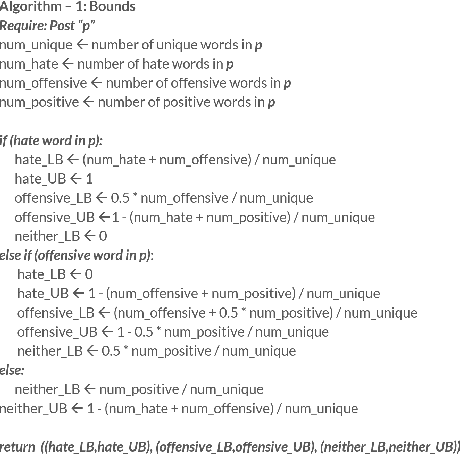
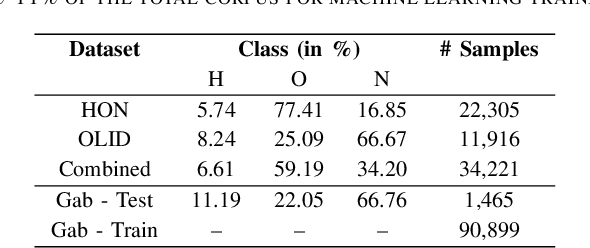
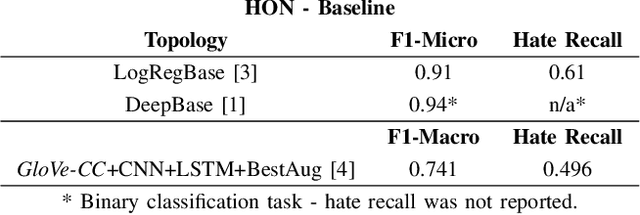
Abstract:Online hate speech on social media has become a fast-growing problem in recent times. Nefarious groups have developed large content delivery networks across several main-stream (Twitter and Facebook) and fringe (Gab, 4chan, 8chan, etc.) outlets to deliver cascades of hate messages directed both at individuals and communities. Thus addressing these issues has become a top priority for large-scale social media outlets. Three key challenges in automated detection and classification of hateful content are the lack of clearly labeled data, evolving vocabulary and lexicon - hashtags, emojis, etc. - and the lack of baseline models for fringe outlets such as Gab. In this work, we propose a novel framework with three major contributions. (a) We engineer an ensemble of deep learning models that combines the strengths of state-of-the-art approaches, (b) we incorporate a tuning factor into this framework that leverages transfer learning to conduct automated hate speech classification on unlabeled datasets, like Gab, and (c) we develop a weak supervised learning methodology that allows our framework to train on unlabeled data. Our ensemble models achieve an 83% hate recall on the HON dataset, surpassing the performance of the state-of-the-art deep models. We demonstrate that weak supervised training in combination with classifier tuning significantly increases model performance on unlabeled data from Gab, achieving a hate recall of 67%.
 Add to Chrome
Add to Chrome Add to Firefox
Add to Firefox Add to Edge
Add to Edge